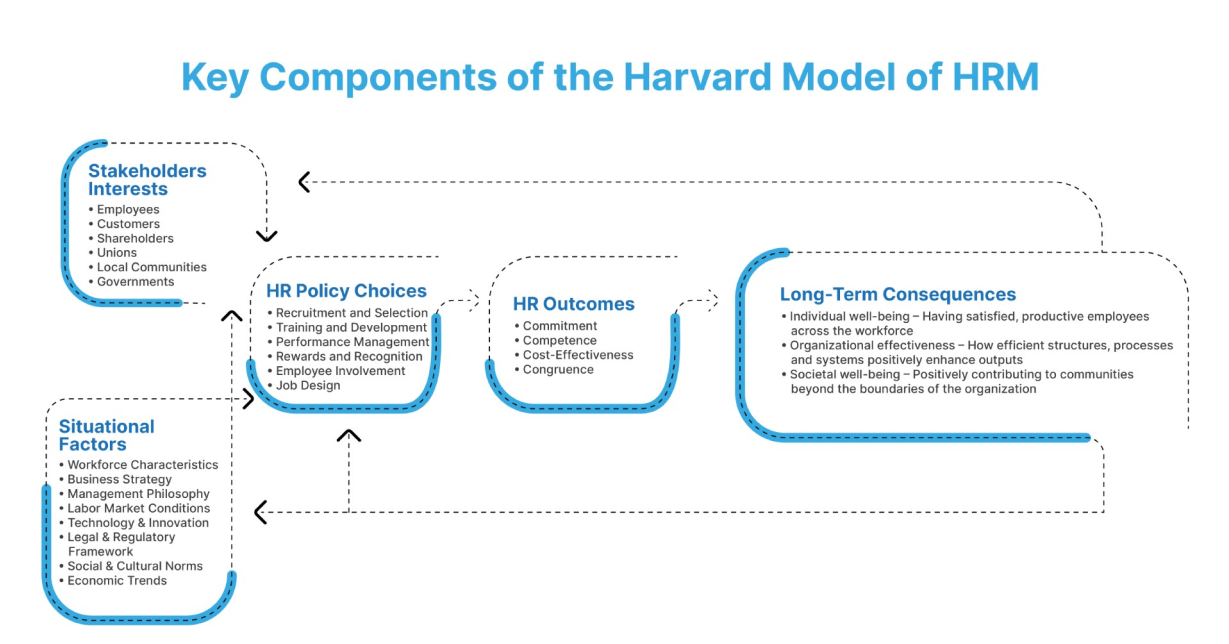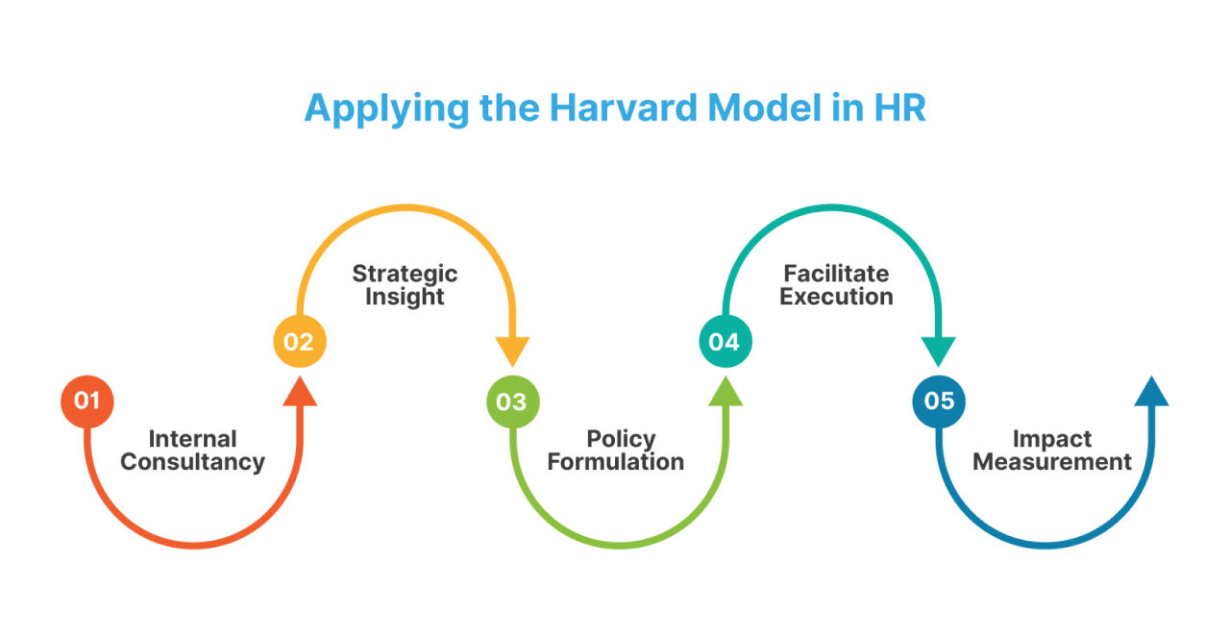
The Harvard Model of Human Resource Management (HRM) has become one of the most influential frameworks guiding the evolution of the HR function within organizations in recent decades. Developed in the 1980s by Harvard Business School professors Beer, Spector, Lawrence, Mills, and Walton, it emphasizes that a range of HR outcomes must be achieved for an organization to be productive and successful.
As opposed to earlier models focused solely on the administrative functions of HRM, the Harvard Framework introduced a more strategic role for the HR department. One aligned directly to overarching business objectives and reliant on close working partnerships between HR professionals and line managers across the organization.
In this article, we’ll cover:
The Harvard Framework sets out the relationship between HR policy choices on areas like recruitment, development, appraisal and rewards, their impact on important HR outcomes such as commitment, competence, cost-effectiveness and congruence, and the consequent effect on long-term business performance and sustainable competitive advantage.
It has five key components:

Human Resource (HR) policy choices refer to the specific strategies and practices implemented by an organization's HR department and leadership team. These policies and approaches drive critical areas such as recruitment, selection, training, development, performance management, rewards, recognition, employee involvement, and job design.
Some of the core HR policy domains include:
HR outcomes refer to the tangible and intangible results stemming directly from an organization's HRM policies and practices. The Harvard Framework Model highlights four key HRM outcomes, known as "The 4 Cs", which signal policy effectiveness:
The cumulative effect of achieving the HR outcomes shapes important long-term consequences regarding:
The model recognizes that multiple stakeholder groups have vested interests in the organization that need accounting for, such as:
Employees
Employees have a deep interest in areas like:
Customers
For customers, primary interests include:
Shareholders
Shareholders main interests are:
Unions
Unions aim to protect employee rights and interests like:
Local Communities
Organizations must also consider their impact on local communities, including:
Governments
Governments ensure that organizations adhere to:
An optimal HR strategy considers which trade-offs between stakeholder interests can result in an approach that brings the greatest overall benefit.
Situational factors influence HR policy choices and outcomes by shaping the external and internal environment in which an organization operates. These include:
These factors directly shape HR decisions and influence the effectiveness of talent management strategies.
The model operates according to the following key principles that remain relevant decades after its inception:
The architects of the model set out to achieve two main objectives that have shaped HR practice since:
There are tangible benefits for HR teams and wider business leadership associated with embracing the Harvard Philosophy within HRM strategy:
To fully leverage the potential of the Harvard Framework to elevate the impact of HRM, HR professionals should focus on the following areas:

As internal consultants, HR professionals should regularly engage with business unit leaders, frontline managers, and employees across the organization. The goal is to fully understand their pain points, challenges, and ambitions in order to gather insights into their needs and preferred workforce strategies.
HR can conduct interviews, surveys, focus groups, and town hall meetings to collect perspectives from multiple stakeholder groups. They should ask questions to understand what is working well and what needs to be improved related to talent acquisition, learning and development, compensation, culture, and other HR focus areas. The insights gathered through broad consultation will allow HR to design integrated policies and practices that directly support the goals and meet the needs of internal clients.
In applying the Harvard Model, HR must develop strategic insight into external and internal factors that necessitate organizational responses. This requires research and analysis on trends related to demographics, technology, competitors, regulations, societal expectations and other external dynamics that can impact workforce objectives. Internally, HR needs visibility into corporate vision and priorities, business unit goals, capability gaps, cost pressures, and changes in leadership strategy.
Armed with rich insights on the external landscape and internal organizational realities, HR can interpret the data to determine what it signifies for the workforce and required HR policies. For example, a sharp industry skills shortage may require prioritizing training programs and retention efforts for skilled talent. Or a corporate growth priority may require significant hiring and onboarding support. Strategic interpretation and translation of external and internal factors allows HR to formulate policies that directly enable the requisite organizational response.
With a sound understanding of organizational needs and priorities, HR can formulate integrated policies across areas like recruitment, training, compensation, and performance management that support coordinated achievement of desired HR outcomes. Policies should reinforce overarching values and culture while providing clear direction to managers on expectations and required actions related to managing their team members.
Care should be taken to ensure alignment across policies. For example, reward policies should recognize and incentivize the behaviors and outcomes emphasized in performance management programs.
Since HR policies send strong cues to employees on expected and valued behaviors, they must align to culture and purported values. Clear, consistent and aligned policies lead to positive outcomes like competence building, talent retention, role clarity, equitable treatment, and trust in organizational leadership. Policy formulation is a critical area where HR must lead in applying the Harvard Model to elevate HR outcomes.
While HR plays the lead role in policy formulation, frontline managers have primary ownership of execution with their teams. As such, HR has an important responsibility to set managers up for success in policy rollout and cascading. HR should assess manager capabilities and gaps related to HR principles and provide customized learning interventions where needed. When new or updated policies are being implemented, HR must create guidance documents, templates, toolkits and training resources so managers thoroughly understand expectations and feel equipped to align team management with the policies.
HR business partners should have oversight of policy execution and continue working closely with managers to reinforce key aspects, offer recommendations based on team dynamics, and provide coaching to instill capabilities. They also need to collect input and feedback from managers and employees on how policies are being adopted. This allows for checking adoption levels and continual refinement of policies and execution support to resolve implementation issues. HR's ongoing support and facilitation of learning for managers is invaluable in achieving intended policy outcomes.
A critical application of the Harvard Model for HR is instituting measurement frameworks to gauge the impact of HR policies on achievement of outcomes. Leveraging analytics technologies, HR should regularly pull metrics related to outcomes like productivity, absence rates, turnover, satisfaction scores, promotion rates, skill development rates to quantify policy impact and identify what’s working well versus opportunities. measurement should inform adaptation of policies and manager support resources to perpetually improve outcomes.
In coordination with business leaders, HR also needs to evaluate how HR policy execution is enabling financial performance and strategic priorities within each business unit. Establishing correlation analysis to tie HR policy outcomes with business performance indicators allows calculation of the ROI on workforce investments and demonstration of HR’s value addition to organizational leadership. Quantified impact deepens buy-in from business leaders on HR policies and justifies continued prioritization of people strategies for superior competitiveness and growth.
Consistent application of diligent measurement practices and use of resulting data enables HR’s agenda of continuous workforce performance optimization through ever-evolving policy formulation under the Harvard framework. Impact quantification and corresponding policy adaptation completes the cycle of strategic HR management for sustainable success.
Decades after its conception, the Harvard Framework for Human Resource Management continues to hold strong relevance as a model that:
By leveraging the core components and principles of the highly influential model within their people management strategies, HR teams can elevate their function to meaningfully drive organizational performance, competitive advantage and sustainable prosperity.

CredBadge™ is a proprietary, secure, digital badging platform that provides for seamless authentication and verification of credentials across digital media worldwide.
CredBadge™ powered credentials ensure that professionals can showcase and verify their qualifications and credentials across all digital platforms, and at any time, across the planet.

Please enter the License Number/Unique Credential Code of the certificant. Results will be displayed if the person holds an active credential from TMI.